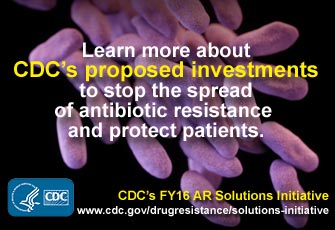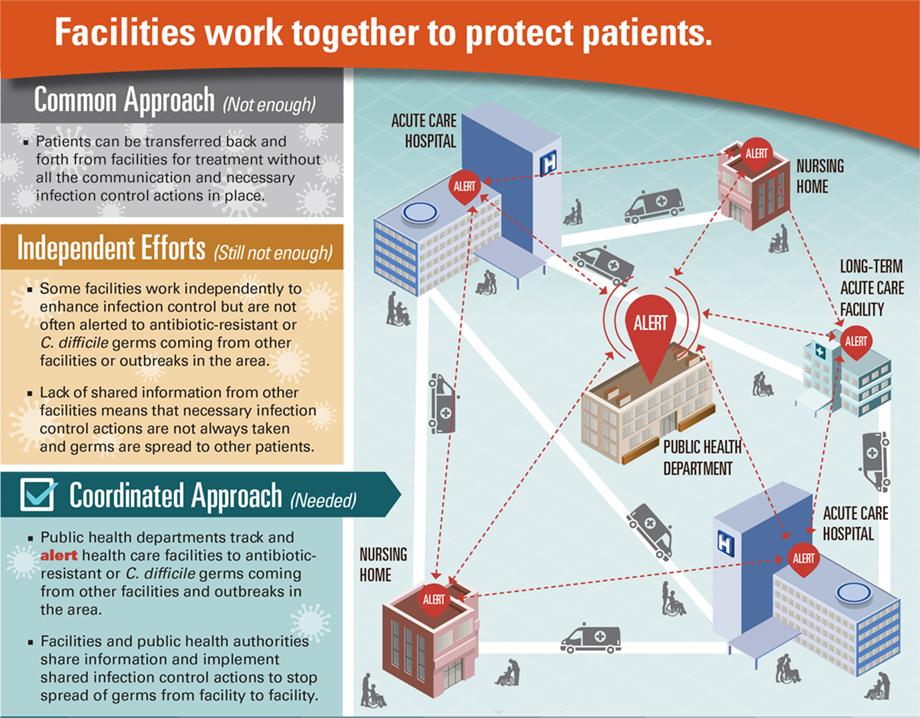Vital Signs: Making Health Care Safer
Stop Spread of Antibiotic Resistance
We’re at a tipping point: an increasing number of germs no longer respond to the drugs designed to kill them. Inappropriate prescribing of antibiotics and lack of infection control actions can contribute to drug resistance and put patients at risk for deadly diarrhea (caused by C. difficile). Even if one facility is following recommended infection controls, germs can be spread inside of and between health care facilities when patients are transferred from one health care facility to another without appropriate actions to stop spread. Lack of coordination between facilities can put patients at increased risk. Now more than ever is the time for public health authorities and health care facilities to work together, sharing experiences and connecting patient safety efforts happening across the state.
Health care facility CEOs/administrators can:
- Implement systems to alert receiving facilities when transferring patients who have drug-resistant germs.
- Review and perfect infection control actions within your facility.
- Get leadership commitment to join healthcare-associated infection (HAI)/antibiotic resistance prevention activities in the area.
- Connect with the public health department to share data about antibiotic resistance and other HAIs.
- Make sure clinical staff have access to prompt and accurate laboratory testing for antibiotic-resistant germs.
Antibiotic-resistant germs cause more than 2 million illnesses and at least 23,000 deaths each year in the US.
Up to 70% fewer patients will get CRE over 5 years if facilities coordinate to protect patients.
Preventing infections and improving antibiotic prescribing could save 37,000lives from drug-resistant infections over 5 years.
Germs spread between patients and across health care facilities.
Antibiotic resistance is a threat.
- Nightmare germs called CRE (carbapenem-resistant Enterobacteriaceae) can cause deadly infections and have become resistant to all or nearly all antibiotics we have today. CRE spread between health care facilities like hospitals and nursing homes when appropriate actions are not taken.
- MRSA (methicillin-resistant Staphylococcus aureus) infections commonly cause pneumonia and sepsis that can be deadly.
- The germ Pseudomonas aeruginosa can cause HAIs, including bloodstream infections. Strains resistant to almost all antibiotics have been found in hospitalized patients.
- These germs are some of the most deadly resistant germs identified as “urgent” and “serious” threats.
C. difficile infections are at historically high rates.
- C. difficile (Clostridium difficile), a germ commonly found in health care facilities, can be picked up from contaminated surfaces or spread from a healthcare provider’s hands.
- Most C. difficile is not resistant to antibiotics, but when a person takes antibiotics, some good germs are destroyed. Antibiotic use allows C. difficile to take over, putting patients at high risk for deadly diarrhea.
Working together is vital.
- Infections and antibiotic use in one facility affect other facilities because of patient transfers.
- Public health leadership is critical so that facilities are alerted to data about resistant infections, C. difficile, or outbreaks in the area, and can target effective prevention strategies.
- When facilities are alerted to increased threat levels, they can improve antibiotic use and infection control actions so that patients are better protected.
- National efforts to prevent infections and improve antibiotic prescribing could prevent 619,000 antibiotic-resistant and C. difficile infections over 5 years.
The Federal government is
- Implementing activities across all government agencies to address the National Action Plan for Combating Antibiotic-Resistant Bacteria[PDF].
- For example, CDC is:
- Protecting more people by tracking outbreaks, monitoring antibiotic use and resistance, improving prescribing, and preventing infections through investment in State HAI/Antibiotic Resistance Protect Programs, as described in the President’s proposed FY16 budget.
- Supporting health departments, health care facilities, health care networks, and professional and quality improvement organizations to track and respond to data about HAIs and antibiotic-resistant infections.
State and local health departments can
- Identify the health care facilities in the area and how they are connected. Know their infection prevention and antibiotic stewardship activities.
- Dedicate staff to improve connections and coordination with health care facilities in the area.
- Work with CDC to use data for action to better prevent infections and improve antibiotic use in health care settings.
- Know the antibiotic resistance threats in the area and state.
Health care facility CEOs/administrators can
- Implement systems to alert receiving facilities when transferring patients who have drug-resistant germs.
- Review and perfect infection control actions within your facility.
- Get leadership commitment to start or join HAI/antibiotic resistance prevention activities in the area.
- Connect with the public health department to share data about antibiotic resistance and other HAIs.
- Make sure clinical staff have access to prompt and accurate laboratory testing for antibiotic-resistant germs.
Prescribers and healthcare staff can
- Prescribe antibiotics correctly. Get cultures then start the right drug promptly at the right dose for the right duration. Know when to stop antibiotics.
- Be aware of antibiotic resistance patterns in your facility and area to protect your patients.
- Ask patients if they have recently received care in another facility.
- Follow hand hygiene and other infection control measures with every patient.
Patients and their families can
- Ask your healthcare provider what they and the facility will do to protect you and your family from an antibiotic-resistant or C. difficile infection.
- Tell your doctor if you have been hospitalized in another facility.
- Insist that everyone wash their hands before touching you, and wash your hands often.
Issue Details
- Vital Signs Issue details: Estimated Effects of a Coordinated Approach for Action to Reduce Antibiotic-Resistant Infections in Health Care Facilities — United States, Morbidity and Mortality Weekly Report (MMWR)
- Vital Signs – Making Health Care Safer [PODCAST – 1:15 minutes]
- Vital Signs – Making Health Care Safer [PSA – 0:60 seconds]
- Vital Signs Video
- Vital Signs Technical Appendix
- CDC Antibiotic/Antimicrobial Resistance Website
- National Healthcare Safety Network
- Core Elements of Hospital Antibiotic Stewardship Programs
- Get Smart: Know When Antibiotics Work
- CDC Get Smart for Healthcare Website
- CDC Healthcare-associated Infections Website
- CDC Safe Healthcare Blog




